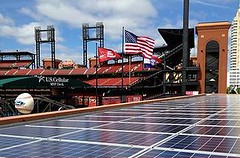 綠色體育聯盟高峰會(Green Sports Alliance Summit)5日在西雅圖舉行第二屆年會,約400名球隊管理人和體育場經營者在現場獲得一份重量級報告,內容是針對4000億美元職業運動產業的「綠化」報告。
綠色體育聯盟高峰會(Green Sports Alliance Summit)5日在西雅圖舉行第二屆年會,約400名球隊管理人和體育場經營者在現場獲得一份重量級報告,內容是針對4000億美元職業運動產業的「綠化」報告。
該報告由非營利性「綠色體育聯盟」與協助成立該聯盟的「美國自然資源保護協會」(Natural Resources Defense Council)所編撰,描述了北美各大運動聯盟的創新環保案例。
在過去的10年裡,這項重大的文化轉變超越了球隊、城市忠誠性與黨派。自2011年由六支球隊組成聯盟至今,已有50多個職業與大學球隊加入,代表超過13個職業聯賽及100多座體育場館。
這份名為《改變遊戲規則》(Game Changer)的報告是獻給美國自然資源保護委員會董事,也就是素有「體育環保化運動之父」美譽的演員兼導演勞勃‧瑞福(Robert Redford)。
 報告由大聯盟主席Bud Selig寫下序言:「所有看著棒球在藍天綠地縱橫飛馳的球迷們,都對環境管理責任有所共鳴。為了後代球迷,我們努力履行社會責任,讓這項全民娛樂持續維護自然資源,並樹立一個他們可以引以為傲的榜樣。」
報告由大聯盟主席Bud Selig寫下序言:「所有看著棒球在藍天綠地縱橫飛馳的球迷們,都對環境管理責任有所共鳴。為了後代球迷,我們努力履行社會責任,讓這項全民娛樂持續維護自然資源,並樹立一個他們可以引以為傲的榜樣。」
報告審查了自2003年以來各聯賽、球隊與場地在營運與供應鏈方面的變化。當年,美式足球費城老鷹隊(Philadelphia Eagles)對其主場館「林肯金融體育場」進行了職業體育場館第一次的綠化改造工作。在這項第一例體育綠化計畫中,美國自然資源保護協會扮演技術顧問的角色,並幫助建立了多樣的綠化措施以限制碳排放量。
報告顯示,10年後,不僅可避免數百萬磅的碳排放、省下數百萬加侖的水、數百萬磅的紙製品轉向再生材質或減量,也會省下數百萬磅的食物可發給饑民。
今年,林肯金融體育場將成為美國第一個能夠100%能源自足的運動場館,他們透過天然氣和生質柴油、超過11000片太陽能板與14個微型風力發電機組合的混合發電機,來產生能源。
未來,太陽能板、風力發電機、回收桶與堆肥計畫、高效節能LED燈與領先能源與環境設計(Leadership in Energy and Environmental Design, LEED)認證的場地等,這些項目都陸續出現在北美各地的體育場館。
 國家冰球聯盟(National Hockey League, NHL)發言人Bernadette Mansour表示,NHL的綠化計畫自2010年冬季經典賽公佈後,一直尋求最有效的節能方式以減少能源使用和花費。Mansour表示,2011-12賽季,國家冰球聯盟綠化活動開始了「得分救水源」(Gallons for Goals)計畫,承諾在常規賽中的每次得分都會為俄勒岡州(Oregon)水位嚴重降低的河川注入1000加侖的水,。
國家冰球聯盟(National Hockey League, NHL)發言人Bernadette Mansour表示,NHL的綠化計畫自2010年冬季經典賽公佈後,一直尋求最有效的節能方式以減少能源使用和花費。Mansour表示,2011-12賽季,國家冰球聯盟綠化活動開始了「得分救水源」(Gallons for Goals)計畫,承諾在常規賽中的每次得分都會為俄勒岡州(Oregon)水位嚴重降低的河川注入1000加侖的水,。
至4月賽季結束,透過博納維爾環境基金會(Bonneville Environmental Foundation)水資源復育計畫(Water Restoration Certificate Program)的努力,「得分救水源」計畫對迪舒斯河(Deschutes River)貢獻了超過650萬加侖的水。
Mansour亦表示,藉由捐贈的未食用食物至各收容所,國家冰球聯盟已提供了22萬份餐點給有需要的人,而沒讓這些食物被倒入垃圾掩埋場。
9月6日,Allen Hershkowitz博士(美國自然資源保護協會資深研究員與該報告共同作者)在綠色體育聯盟高峰會中詳細說明該報告,其中包括10個綠化策略。
當天晚上,綠色體育聯盟高峰會將於西雅圖水手隊主場的薩菲柯體育場(Safeco Field)舉辦慶祝晚會,感謝大聯盟主席Selig對體育綠化活動的支持和領導,並授與環境領導獎(Environmental Leadership Award)。
報告下載網址: http://www.nrdc.org/game-changer
When the second annual Green Sports Alliance Summit opens in Seattle today, some 400 sports executives and venue operators will each receive a fat new report on the greening of the $400 billion professional sports industry.
Compiled by the nonprofit Green Sports Alliance and the nonprofit Natural Resources Defense Council, which helped found the Alliance, the report features case studies of innovative greening initiatives from every major sports league across North America.
This major cultural shift has, over the past 10 years, transcended team and city allegiances and political parties to include more than 50 professional and collegiate teams, representing over 13 professional leagues and over 100 sports facilities now in the Green Sports Alliance, up from the six teams that founded the Alliance in 2011.
Entitled “Game Changer,” the report is dedicated to actor-director Robert Redford as an NRDC Trustee and “father of the sports greening movement.”
It features a preface by Major League Baseball Commissioner Bud Selig, who writes, “Environmental stewardship resonates with all of us who love baseball and seeing it played on green grass and under blue skies. As we strive to fulfill our social responsibilities, the national pastime will continue to protect our natural resources for future generations of baseball fans and set an example about which they can be proud.”
The report examines changes that leagues, teams and venues have made to operations and their supply chains since 2003, when the Philadelphia Eagles football team conducted the first green renovation of a professional sports stadium at Lincoln Financial Field.
The Natural Resources Defense Council served as a technical adviser on that first sports greening project and helped develop a wide-ranging greening initiative that went way beyond limiting carbon emissions.
Ten years later, the report shows, not only have millions of pounds of carbon emissions been avoided, millions of gallons of water have been saved, millions of pounds of paper products are being shifted toward recycled content or eliminated, and millions of pounds of uneaten food have been distributed to feed hungry people.
This year, Lincoln Financial Field will become the first stadium in the United States capable of generating 100 percent of its own energy through a mix of power from a generator that runs on natural gas and biodiesel, more than 11,000 solar panels and 14 micro wind-turbines.
Solar panels, wind turbines, recycling bins and composting programs, energy efficient LED lights and LEED certified venues – all these are making their appearances in sports stadiums and arenas across North America.
National Hockey League spokesperson Bernadette Mansour said the NHL Green initiative was announced at the 2010 Winter Classic and since then has sought the most energy efficient operations to reduce energy use and costs.
During the 2011-12 season, she said, NHL Green introduced Gallons for Goals, a pledge to restore 1,000 gallons of water to a critically dewatered river in Oregon for every goal scored during the regular season.
By season’s end in April, working through the Bonneville Environmental Foundation’s Water Restoration Certificate Program, Gallons for Goals had contributed more than 6.5 million gallons of water to replenish the Deschutes River.
By donating all untouched food to shelters, Mansour said the NHL has donated 220,000 meals to the needy, keeping this food out of landfills.
On Thursday, Hershkowitz will present a keynote address to the Green Sports Alliance Summit that will cover the report in detail, including 10 greening strategies that work.
On Thursday night, a gala event to benefit the Green Sports Alliance at Seattle’s Safeco Field will celebrate Commissioner Selig’s support and leadership in greening Major League Baseball by presenting him with an Environmental Leadership Award.
※ 全文及圖片詳見 ENS

